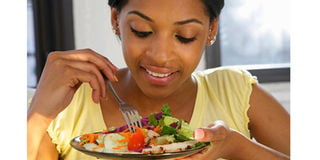The best foods to break a fast

Eat fruits and vegetables since they are a source of nutrients your body will be craving after a fast. Net Photo
What you need to know:
- When to eat. Bena Okiria, a nutritionist says: “There may not be particular rules on how often you should eat after breaking your fast. It is dependent on the individual but if you are going to fast the next day, ensure to get enough calories so you will not feel tired the next day.”
- Also, if your craving and hunger are out of control by the time you break your fast, consider reducing the time you fast and increase when your body gets used to managing your craving and hunger.
Abstaining from solid foods for aperiod beyond your normal eating routine (fasting) is known to be helpful in detoxifying and repair of body tissues since digestion is put on hold. It also helps with loss of fat since the body is allowed to burn fat for energy when there is scarcity of food.
After intermittent fasting, which may take about (12 to 18 hours), there should be a healthy way to break your fast in order to refuel. Breaking your fast the wrong way can cause bloating of the stomach, a lethargic feeling the next day.
According to Lilian Nyanzi, a nutritionist at Neulife Medical Centre, do not use the excuse of abstaining from food to feast on junk food. She adds that while breaking your fast, you should focus on energy rich and nutrient dense foods that will keep you full throughout the next day.
The first phase
Nyanzi says you should focus on getting plenty of proteins, healthy fats and fibre but start with easy to digest foods and fluids that will be gentle on your digestive system. These should be nutrient dense in order to satisfy the craving your body may have at the time of breaking your fast.
“Some of the best foods to break your fast with can include boiled eggs, unsweetened yoghurt, freshly prepared fruit or vegetable juice, fruits such as pawpaw, avocado, mangoes and watermelon, among others. Cooked vegetables such as spinach, vegetable soups, and bone broth can also be good options for people who are breaking their fast,” she says.
Nyanzi also warns people to avoid sugary drinks because they provide empty calories. Taking caffeinated drinks such as coffee on an empty stomach can make you feel nauseous.These should be replaced with vegetable soup and bone broth. Remember to drink as much fluids (water) to help in the digestion process of the next phase of food.
The second phase
Bena Okiria, a nutritionist, says the foods here are a bit harder to digest but aim at getting more calories from proteins healthy fats than from carbohydrates if your goal is to lose weight. This will help the body to deplete the sugar reserves.
“Foods such as raw vegetables, nuts and seeds, whole grains and beans can be very handy in making you feel full for longer and reducing your sugar cravings. Cut out processed food since the processing removes the foods’ nutrients. Also, cook your own meals and control the amount of salt used,” she says.
She also adds that you should listen to your body, know how you feel and make the necessary adjustments. With this, you will be able to practice mindful eating.
This kind of eating will also help you follow your sensation to hunger and stop eating when you feel satisfied. You should also eat slowly, avoid talking while eating and chew thoroughly to prevent air finding its way into the stomach because it will cause digestion problems.




